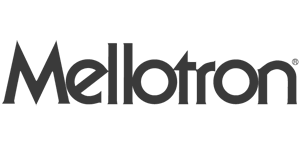
Mellotron, the ancestor of digital samplers, released in England, was very popular in the 60-70s. The polyphonic electro-mechanical keyboard emitted the sound with the help of magnetic tapes triggered by pressing a key and each key was connected to its own mechanism which used a magnetic tape with the recorded voice of the corresponding note. The mechanism is extremely simple - when you release the key, the tape, which could sound for up to eight seconds, was rewound to the beginning. You could switch the tapes along or across: a few sounds could be recorded along the tape, while up to 3-4 tracks could be pre-configured across - the tape head moved along or across the tape according to the selector position which you could adjust on the control panel.
Mellotron was far from the most reliable musical instrument, since the heads had to be cleaned from time to time, their position was to be regulated, and sometimes you had to repair the pinch rollers and return springs. Yes, their sound was quite unique due to such nuances, but considering practicality, it is not surprising that Mellotrons were replaced by digital samplers quite quickly. However, in the 90's Mellotron was back in demand.
The instrument was loved for its versatility - it's possible to record anything on the tape, even the voices of synthesizers of that time.
The memory offered by first samplers was inferior to that of the Mellotron.
It all started with Chamberlin, the precursor of Mellotron. The instrument invented by Harry Chamberlin would seem now an even more wonky option. Not having time to properly care about the production of an instrument that required 70 tape heads for its design, each of which must be calibrated perfectly (not to mention that any production is successful only when it is put on stream, and as for the production deadlines - Harry also had some problems there), Chamberlin turned to Bradmatic. The instrument was revised and re-planned, as well as badged with a new name - Mellotron. There was also an independent company engaged in the sale and recording of tapes - Mellotronics. It’s worth noting that the rights for Mellotron release were purchased from Harry only in 1966.
When in 1977, an American company that was distributing Mellotron went bankrupt, Mellotronics had to close down, and the company, which was once contacted by Harry who asked for some help with production, lost the rights to the name Mellotron - they were given to a new company called Sound Sales. Thus, employees of the former Bradmatic (later called Streetly Electronics) were forced to rename their product to Novatron, since Mellotron at that time belonged to the Americans from Sound Sales.
Music of the 60s and 70s, ringing sometimes with a rumbling echo, and sometimes with a decadent aftersound in the tracks of rock bands of the 90s, gave the new young musicians a Mellotron, calling either for an obvious manifesto against the 80s, or for quiet nostalgia making the members of Oasis, The Smashing Pumpkins, Marillion, Radiohead, Red Hot Chili Peppers turn to retro ways of producing music.
When Mellotron was not a ghost but a real boom-maker, the instrument was very popular with The Beatles, Led Zeppelin, Genesis and The Rolling Stones. Bryan Jones, being a multi-instrumentalist record-holder, was one of the first professionals who dealt with Mellotron masterly. It might have taken him a couple of hours.
Mellotron was one of the eminent heroes of the progressive rock back in the 70's: thanks to Yes and Manfred Mann.
The first model of Mellotron was based on Chamberlin 600 Music Master – two 35-note keybeds, where the left one offered sections of rhythm and accompaniment, and the right one - 18 solo voices. The tape carried 6 banks and three tracks (two neighboring ones could be played at once), 2 built-in speakers, a spring reverb, a tube preamplifier and 2 transistor power amplifiers.
Fx Console was developed for radio and television in 1965 at the request of BBC, offering 1260 recorded sound effects and a slightly modified, one might even say a simplified structure: weak speakers and amplifier, budget enclosure, lack of reverb and lack of the ability to playback adjacent tracks simultaneously - the instrument was rebuilt according to the target requirements, reducing the noise and including the headphone output with a volume control.
A more compact, light version of Mark II release - M300 - was developed. Only this model featured 4" 2-track tapes, which could not be played simultaneously.
M400 became not only the most successful portable version, but also the most famous one. SMS-10 circuit, which required long time to get loaded, was replaced by SMS-2 in 1973. Instead of banks, tape cassettes were used. By purchasing new cassettes, you could easily change the sounds of your instrument. Later Mark V appeared - a rather rare specimen which combined two M400 units.
4 Track, produced in the US, had a rather low quality of recorded sounds, but from a technical point of view was more complicated than its predecessors – 4" 4-track tapes allowed playback of 4 tracks simultaneously.
Mark VI/VII sported more reliable and stronger components, offering a new format of cassettes.
The M4000 reminds of M400, but incorporates the earlier principle of a banks system for easy switching. In addition to the already recorded 24 standard sounds you could add the new ones since the company sold tapes with recorded instruments which you could choose from a big library.

